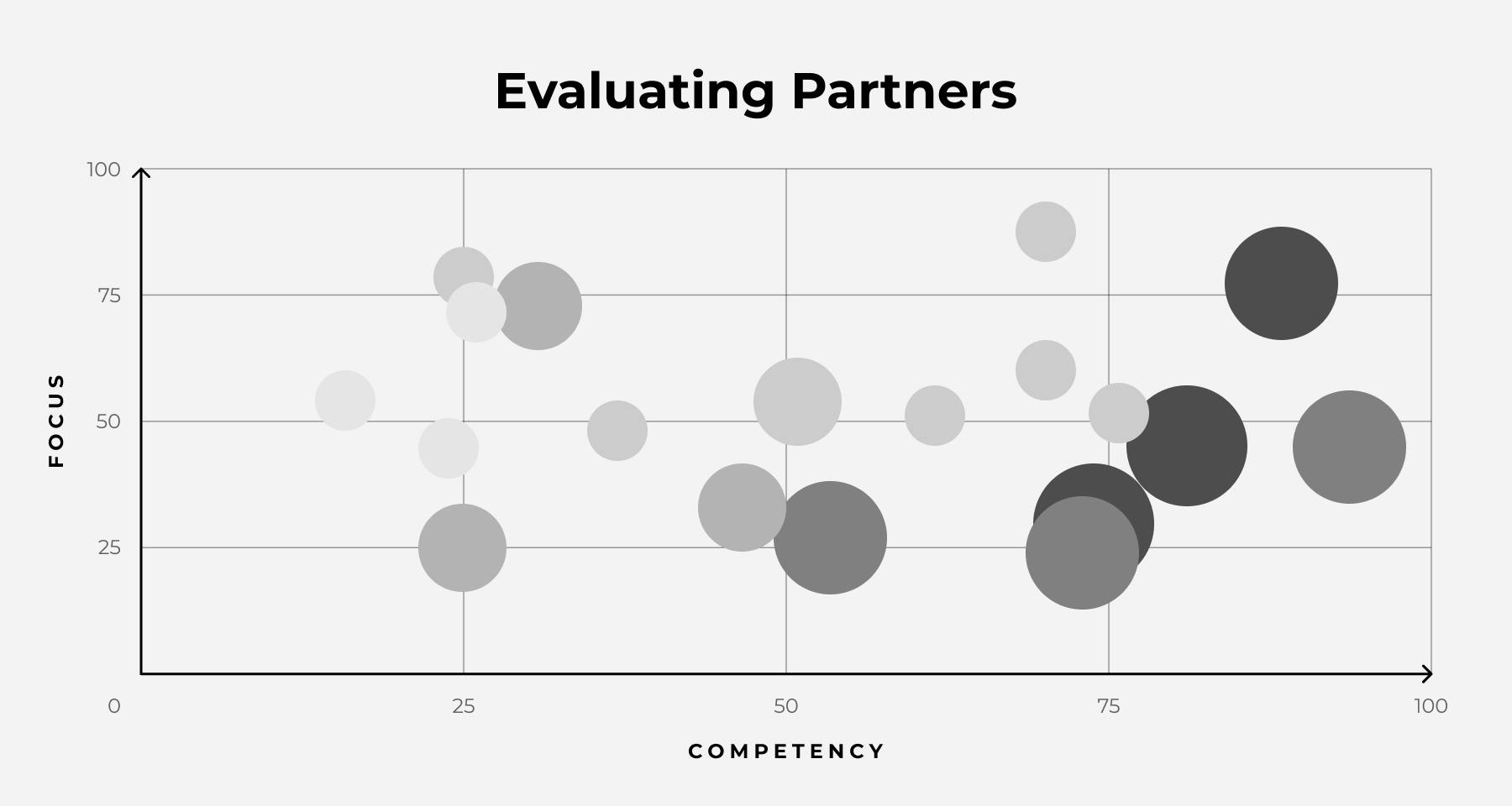13.6 minutes

Wherever we are, export markets represent 20X or more of the size of our domestic market.
The international expansion gives us access to more consumers, faster-growing economies, and diversification of our markets.
What we learn at business school doesn’t prepare us for Global GTM.
Three primary things impact Global GTM:
- What markets to focus resources on.
- The channel partners who will be selling our products.
- The correct systems to manage the channel partners to drive mindshare and competency.
I’m going to dig into these below. I will start with two general statements – everything needs to be done with intent, and the single most crucial piece to your Global GTM success (for a company under $500 mil total sales) is channel partner mindshare. These will drive growth in your Global GTM.
I have attended more than one event hosted by serious people discussing finding channel partners. What is taught is “get a booth at a trade show, wait for people to come into your booth, appoint them your distributors and give them the marketing material they ask for.” Essentially, taking control of what markets you will sell to, who will sell for you and how you manage them all out of your hands.
Identify the markets you want to prioritize and stick to that; find the partners you want to work with; don’t let random people pull you into wasting your resources; manage your channel partners as though they were your domestic sales team.
How do we choose the right markets? The first step is to take a good look at the solution we are trying to sell. Why do people buy it? When do they buy it? Is there a compelling event (birth of a child;) that triggers the purchase? What do I know about the people who are buying it today? I will put together a profile of the perfect end users and then look for markets where a lot of these potential end-users are.
Where can I find the data to find these markets once I know what I am looking for?
I start with a few places – the CIA World Factbook, the World Bank, and the US Commercial Service. All of these websites have extensive demographic, economic, and political data. My website www.globalsalesmentor.com has data on over 100 markets that have distilled relevant GTM economic and demographic data.
Once I have put together a list, I then go through and remove the markets that might be difficult based on legal restrictions, trade restrictions, or in some cases, a powerful indigenous competitor. I can find these “red lights” by talking to the local commercial service representatives, the World Bank, and sometimes on the CIA Factbook. Of course, this is a very brief run-through of a vast subject, but this summary will still put you on the path to do it with intent.
To find the right partners, we need to look at our sales process and figure out what we need the partners to do. What exactly are the activities that we expect from them to build a profile of the perfect channel partner?
The first question is, “are they presently selling something with a similar price point and a similar sales cycle to the end-users I need to sell to?” I will very seldomly work with a partner where that isn’t the case. Think about this – to sell, I need to find the customers, establish rapport and help the customer internalize that my product solves their problems. Then having a distributor that knows the customers, already has an established connection, and has a track record of assisting the customer in internalizing data, reduces my ramp-up time by 90%.
We often get tied up on the technical part of what they need. Here is the thing – technical skills can be bought on the cheap – if they need an installer or a service tech, you can make them hire one; if they can’t sell, you can’t fix that.
Of course, building this list of what I want can be a great deal more complex than the above, but once I have that list, then I go out and find the partners I want to work with within the markets I want to play in. This is a complete reversal from the “get a booth at a trade show and wait for random people to walk in” strategy, and you will see a considerable impact on GTM with this.
How do I find these partners now that I have identified the profile?
If I know the profile, I should be able to figure out what they are selling today. I am looking for a solution that is being sold to the same end-user, with a similar sales cycle and similar price point. But not a competing product (it is a lot of work to shift a good channel partner from a competing product, and if they are easy to shift, you have to wonder how loyal they are).
I can then find these partners through the websites, LinkedIn, and online catalogs of local trade shows (distributors that have booths at local trade shows will list the product lines they represent.) Or, by calling the local commercial service people and asking specifically “who represents company X in your market?” I can reach out to my target end-users and ask who they currently like to buy from.
This is a quick way to describe a great deal of work, but I have trained several people from Upwork to do this and, in recent months, have onboarded dozens of channel partners found this way. One client had been trying to find partners for seven months and hadn’t onboarded a single partner; in a week, I was able to introduce him to 2 candidates in each of 25 markets.
Once I have identified this list, I will reach out to them with a simple 3 part pitch by email and Linkedin: this is the market potential. This is why it’s easy to work with me so that you can trust me.
If they are interested, I will set up a Zoom call. One way to expedite this and boost responses is to ask the Commercial attaché in the market to make an introduction. If you reach out to the US commercial officer in the market with the name and contact details of the company you want to meet and ask him to make a call for you, they usually will without a charge, or they will charge you $200. When a distributor gets a call from the US embassy asking to set up a meeting, they will set up that meeting 100% of the time and listen attentively when you talk.
The candidate distribution partners are candidates for my sales organization, and I will treat this very much like I would treat an AE interview. I want to be making the cuts, and I want everyone to want to work with me so that I will start with a strong pitch based on the 3 points above. Distributors need to understand that they can make money from my product, that I will be easy to work with, and that they can trust me. Know what I want them to do, so I build questions around the competencies that I need from them. I will have prepared information about the market, and I want to see if they sell to end-users. I will also check references from other manufacturers that they work with.
There are 3 things that I am going to judge the candidates on Competency, do they have the skills that are listed as required, and how strong are they in those skills; bandwidth – how many resources do they have to cover the market (in total, not dedicated to me); focus, how much of their bandwidth can I expect to have focused on my solution?
I will first remove the not a good fit and matrix out the other candidates based on those three criteria. I can control focus; they will build competency with more emphasis, but bandwidth is typically unchangeable.
With this matrix, I should be able to decide what partner is the best fit for the market.
Choosing the right partner in the right market is the beginning of Global GTM. Managing the partner as though they were a part of the direct domestic sales team is what drives colossal growth and revenue and is the most elusive and challenging.
The first step is realizing that you should be clear in the agreement about what you expect from the partner. Instead of setting financial goals in the first two years, set activity goals. What do you expect in 30 days, 60 days, 90 days – two years? If you select a plan for X sales in a year, he has a year to laze around before you terminate him, at no cost to him. If you set activity goals, he has to be showing you his work from the beginning, and if he does the correct work, the sales will follow.
When you start asking activities of a channel partner after the agreement is signed, he has no real incentive to follow those procedures. When you put them in the agreement, he will respect your professionalism and put effort into carrying out the activities.
Of course, we need to implement the systems and processes for managing the distributors to ensure growth and success. This will require onboarding training tools, communication protocols, a playbook for selling and interfacing with HQ, and a system for periodic evaluation. I have been getting excellent use out of apps like Notion and Kajabi for this in recent years. It can be a challenge to add oversight and accountability to distribution partners years into the process, but it is easier if we start from day one with clarity.
I’ve spent the past 35 years managing Global GTM. This has included dozens of products for close to 20 companies, 135 countries, over 1000 distribution partners, and over $1 billion in sales. Between B School, dozens of books on selling, workshops, and various other sources, I picked and gleaned pieces of knowledge to stick together to fit this subject because I didn’t feel that anybody covered this in a way that was useful and practical. This 2000-word essay was an intent to distill that 35 years of experience.
